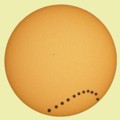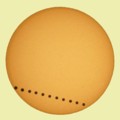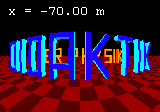- 2013-04-05
Complete series of photos made by participants of the photography project are now available. They make it possible to comprehend the procedures described in this project and to derive the distance to the Sun by own evaluations.
- 2012-09-16
After the evaluation of some additional complete series of transit photos the final results of the photographing project could be derived. The best results differ from the exact measure by only one percent. But the large differences in the quality of the images and several problems during the evaluation enable to understand the historical difficulties in measuring the distance to the Sun!
The projects are now regarded as terminated.
- 2012-09-04
The algorithm for the evaluation of contact times and the related worksheets must slightly be corrected. Together with some additional contact data we now can derive very satisfying measures for the distance to the Sun from the contact data of this project, see the according result page.
- 2012-08-04
Both projects have successfully been finished. Although not as many pictures and contacttime measurements as expected have been submitted the results of the photography project and of the contacttimes project are quite satisfying. They not only yield quite good own measures of the distance to the Sun but allow to make the parallaxe of Venus visible.
During the evaluation the resources evaluationofcontacttimes1+2.xls, evaluationofcontacttimes3+4.xls, evaltransitpicts, comptransitpos and comp2Venuspositions.xls had slightly to be corrected.
For the comparison with the SDO images a third order fit has been determined to the corresponging positions of Venus (see Coordinates_Geocentric.xls)
- 2012-07-17
The worksheet comp2Venuspositions.xls and the program comptransitpos have been actualized so that comparisons between selfmade pictures and SDO pictures can easily be done. To make the procedure clearer the single evaluation page has slightly be changed.
- 2012-07-10
The procedure of evaluating "single exposed pictures" has been described in more detail (see single evaluation).
- 2012-06-23
First evaluations of uploaded photos have been done - because of unknown orientation and/or the lack of suitable partners with the help of SDO images (see the result page). The combined pictures visualize the parallaxe of Venus!


The pictures show that the photograph of the left picture was south of the spacecraft while the other was north of it.
As well, some more contact time data allow the calculation of the distance to the Sun with a little better statistics (see the corresponding result page). For instance, the contact 2 data yield a mean measure of the solar parallaxe of π=9.00".

- 2012-06-09
Because of little mistakes the sheets for evaluating the contact1/2 and contact 3/4 data have been updated.
Up to now very few contact time measurements have been transferred to our project. Only the contact 3 data allow a first very preliminaray evaluation (see the result page).
- 2012-06-04
We wish all participants good luck and success!
We have collected last tips for the transit and we propose to send transit impressions (experiences, pictures, ...) to one of the authors below. If we will get enough "stuff" we will establish an extra impressions page.

The rotation of the Sun May 24th-May 28th
As Venus in hours sunspots "move" in days. The method of making the Sun's rotation visible equals that to follow the path of Venus over the solar disc. For those who need material for exercising the suitable rotation of twice exposed pictures with the program evaltransitpicts we offer a zipped archive containing the results of all steps described in the basic ideas and the example of the photographing project.
- 2012-05-28
Venus comes closer and closer!

Venus on April 23th and May 25th
- 2012-05-26
The mathematical details of the contact time project have been completed.
- 2012-05-22
Since May 16, Venus moves retrograde. Therefore, the second method of measuring the radius of its orbit can now be applied. But measuring the celestial position of Venus will become more and more difficult during the following days because the angular distance between Venus and the Sun will diminish quickly!
- 2012-04-23
tableofVenuspositions.xls and the filled versions of it have been changed so that they work properly even with Open Office.
These days, it is very worth looking to the Sun and exercising to take twice exposed pictures!

The Sun, April 23th, Δt=150s, now properly exposured
- 2012-04-21
The sheets and programs have slightly been corrected and their use is now be illustrated in some detail on the basis of 2004 photos in one example and with calculated position data of the actual transit in another one.
- 2012-04-19
The programs and worksheets for combining and evaluating measured positions of Venus have now been uploaded (see the stuff page and the data transfer page).
May be you will find there in the next days an additional example illustrating the use of these utilities.
- 2012-04-11
It's time now to prepare the taking of twice exposed photos of the Sun. Possible sunspots will offer the possibility of position measurements as described in "Photographing the Sun and measuring exact position of Venus" (and, perhaps, discovering the Sun's rotation!)

The Sun, April 7th, Δt=150s
The position of the little sunspot can be measured.
- 2012-04-04
The pages of the contact times project have been completed. There you will find operation details, a possibility for exchanging data and evaluation procedures.
The pages of the photographing project will be finished very soon.
- 2012-03-19
All people, pupils, teachers, amateurs, professional astronomers and so on, interested in attending these projects are invited to inscribe themselves as participants by writing an email to Udo Backhaus (adress see below). They will get the possibiltity to contact other project partners and will be kept informed about any actuality.
- 2012-03-17
Venus will reach its maximum angular distance to the sun, e. i. its maximum elongation, on March, 27th. The days around that date offer an optimal opportunity to determine the radius of Venus' orbit around the sun (see our related project).
- 2012-03-01
The data transfer pages of both projects (Simultaneously Photographing and Contact Times) are ready for testing.
 Essen 2004
Essen 2004 Essen 2004
Essen 2004







